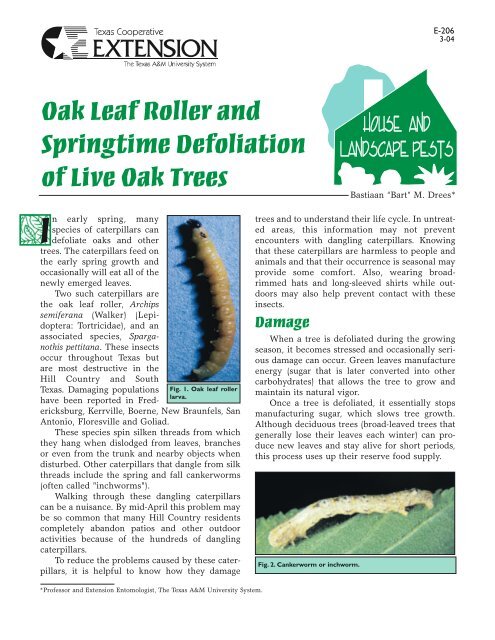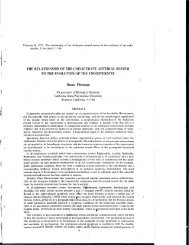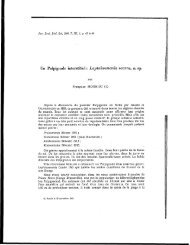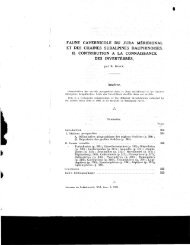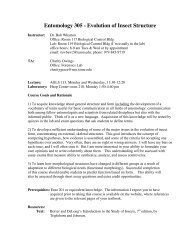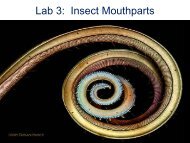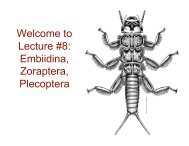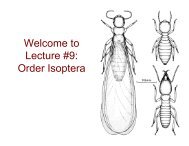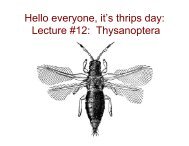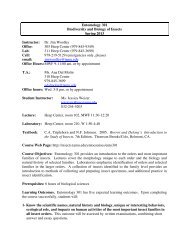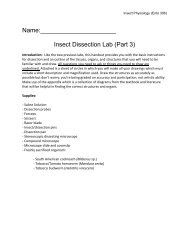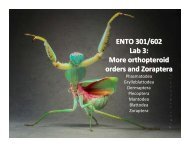Oak Leaf Roller and Springtime Defoliation of Live Oak Trees
Oak Leaf Roller and Springtime Defoliation of Live Oak Trees
Oak Leaf Roller and Springtime Defoliation of Live Oak Trees
- No tags were found...
Create successful ePaper yourself
Turn your PDF publications into a flip-book with our unique Google optimized e-Paper software.
E-2063-04<strong>Oak</strong> <strong>Leaf</strong> <strong>Roller</strong> <strong>and</strong><strong>Springtime</strong> <strong>Defoliation</strong><strong>of</strong> <strong>Live</strong> <strong>Oak</strong> <strong>Trees</strong>Bastiaan “Bart” M. Drees*In early spring, manyspecies <strong>of</strong> caterpillars c<strong>and</strong>efoliate oaks <strong>and</strong> othertrees. The caterpillars feed onthe early spring growth <strong>and</strong>occasionally will eat all <strong>of</strong> thenewly emerged leaves.Two such caterpillars arethe oak leaf roller, ArchipsFig. 1. <strong>Oak</strong> leaf rollerlarva.semiferana (Walker) (Lepidoptera:Tortricidae), <strong>and</strong> anassociated species, Sparganothispettitana. These insectsoccur throughout Texas butare most destructive in theHill Country <strong>and</strong> SouthTexas. Damaging populationshave been reported in Fredericksburg,Kerrville, Boerne, New Braunfels, SanAntonio, Floresville <strong>and</strong> Goliad.These species spin silken threads from whichthey hang when dislodged from leaves, branchesor even from the trunk <strong>and</strong> nearby objects whendisturbed. Other caterpillars that dangle from silkthreads include the spring <strong>and</strong> fall cankerworms(<strong>of</strong>ten called "inchworms").Walking through these dangling caterpillarscan be a nuisance. By mid-April this problem maybe so common that many Hill Country residentscompletely ab<strong>and</strong>on patios <strong>and</strong> other outdooractivities because <strong>of</strong> the hundreds <strong>of</strong> danglingcaterpillars.To reduce the problems caused by these caterpillars,it is helpful to know how they damagetrees <strong>and</strong> to underst<strong>and</strong> their life cycle. In untreatedareas, this information may not preventencounters with dangling caterpillars. Knowingthat these caterpillars are harmless to people <strong>and</strong>animals <strong>and</strong> that their occurrence is seasonal mayprovide some comfort. Also, wearing broadrimmedhats <strong>and</strong> long-sleeved shirts while outdoorsmay also help prevent contact with theseinsects.DamageWhen a tree is defoliated during the growingseason, it becomes stressed <strong>and</strong> occasionally seriousdamage can occur. Green leaves manufactureenergy (sugar that is later converted into othercarbohydrates) that allows the tree to grow <strong>and</strong>maintain its natural vigor.Once a tree is defoliated, it essentially stopsmanufacturing sugar, which slows tree growth.Although deciduous trees (broad-leaved trees thatgenerally lose their leaves each winter) can producenew leaves <strong>and</strong> stay alive for short periods,this process uses up their reserve food supply.Fig. 2. Cankerworm or inchworm.*Pr<strong>of</strong>essor <strong>and</strong> Extension Entomologist, The Texas A&M University System.
More importantly, these stressed trees aremore susceptible to attack by various diseases <strong>and</strong>insects. Weakened trees are extremely susceptibleto wood-boring insects such as longhorn beetles,flat-headed tree borers, shot-hole borers <strong>and</strong> manyclear-winged tree borers. (For more informationon these insects, see the Texas CooperativeExtension publication B-5086, Wood-Boring Insects<strong>of</strong> <strong>Trees</strong> <strong>and</strong> Shrubs.)If the trees are completely defoliated yearafter year, especially under the drought conditionsthat are common across Texas, they will die.Life cycleThe adult moth<strong>of</strong> the oak leafroller, Archips semiferana,is about 1/2inch long. Its wingsare mottled brownwith dark brownmarkings. Sparganothispettitana (nocommon name) haslemon yellow wings<strong>and</strong> ranges from 1/2to 3/4 inch long.Both species undergo one generation eachFig. 3. <strong>Oak</strong> leafroller moth (left) <strong>and</strong>pupal skin (right).year. In May, moths <strong>of</strong> both species lay their eggson the twig tips <strong>and</strong> leaf buds <strong>of</strong> several differenttree species. The eggs remain on the buds or twigsfor about 10 months <strong>and</strong> begin to hatch in mid-March.Once they hatch,the caterpillars, or larvae,feed on the tendernew spring growth <strong>of</strong>the trees from mid-March until late April.The larvae are creamywhite to greenish <strong>and</strong>have dark black orbrown head capsules.They develop throughseveral stages, orinstars, as they matureto about 3/4 inch long.Fig. 4. <strong>Oak</strong> leaf roller mothlarva (above) <strong>and</strong> adult (below.)<strong>Trees</strong> that are heavily infested will usually bedefoliated by mid- to late April, when the fullygrown caterpillars form the pupa stage on the tips<strong>of</strong> twigs, in bark crevices or on weeds <strong>and</strong> otherplants growing near the infested trees.Fig. 5. <strong>Oak</strong> leaf roller, Archips semiferana (Walker) (Lepidoptera:Tortricidae) adult (left), pupal skin (center) <strong>and</strong> caterpillar(right), collected from oak trees, March 2002.At about the first <strong>of</strong> May, moths begin toemerge from the pupal stage (cocoon) <strong>and</strong> beginlaying eggs on the twigs <strong>of</strong> oak, hackberry, pecan<strong>and</strong> walnut trees. These eggs will again remaindormant until the following March, thus completingthe 1-year life cycle.ManagementFor most oak trees throughout the HillCountry, it is not feasible to use insecticides tocontrol the oak leaf roller <strong>and</strong> its related species.Often the best course <strong>of</strong> action is to simply donothing. Post oak trees have survived in South <strong>and</strong>Central Texas without human interventionthrough time, despite periodic pest outbreaks <strong>and</strong>resulting defoliation. Caterpillar pest populationsare generally cyclic, <strong>and</strong> they rarely occur yearafter year.The oak leaf roller doeshave a few natural enemies.The best natural controlappears to be provided byseveral types <strong>of</strong> parasiticwasps that attack <strong>and</strong> kill theoak leaf rollers. However,there are seldom enough <strong>of</strong>these wasps to curtail an outbreak.Certain birds, includingmockingbirds, have alsobeen observed feeding on thedangling caterpillars.Fig. 6. Close-up <strong>of</strong> oakweb worm caterpillar.2
In residential situations, however, valuablel<strong>and</strong>scape or orchard trees may need to be protectedfrom caterpillar outbreaks. Valuable l<strong>and</strong>scapetrees with a history <strong>of</strong> leaf roller infestation<strong>and</strong> defoliation should be watched closely frommid- to late March. If heavy leaf-feeding damageis observed, the tree leaves can be sprayed with aregistered insecticide containing either carbaryl(such as Sevin®), the insecticide that containsBacillus thuringiensis var. kurstaki, or any <strong>of</strong> severalother products labeled for control <strong>of</strong> "caterpillars"or "oakworms" on ornamental trees <strong>and</strong>shrubs.To minimize stress <strong>and</strong> to restore plant vigor,oaks or other trees that have been severely defoliatedin the past should be fertilized <strong>and</strong> wateredregularly. Choose a balanced fertilizer (one thathas equal amounts <strong>of</strong> the three major elementsnitrogen, phosphorus <strong>and</strong> potassium) <strong>and</strong> apply itat the rate <strong>of</strong> 1 pound <strong>of</strong> nitrogen (N) per diameterinch <strong>of</strong> the trunk at waist height.Apply the fertilizer in a circular pattern withinthe tree's drip line, which is the area undera tree from the trunk to the outermost limb.For best recovery <strong>of</strong> the trees, apply ammoniumsulfate (21-0-0) at the same rate 6 to 8 weeks later.AcknowledgmentsThis fact sheet was originally developed byJ. W. Stewart, Extension entomologist, <strong>and</strong> BobBailey, county Extension agent for KendallCounty, as part <strong>of</strong> the Upper Coast series, No. 21.Their publication, <strong>Defoliation</strong> <strong>of</strong> <strong>Live</strong> <strong>Oak</strong> <strong>Trees</strong> bythe <strong>Oak</strong> <strong>Leaf</strong> <strong>Roller</strong> <strong>and</strong> a Closely Related Moth, waspublished in April 1993.The author wishes to thank James Reinert,Roger Gold <strong>and</strong> Michael E. Merchant for review<strong>of</strong> this manuscript.Photographs <strong>and</strong> line drawings by Bastiaan"Bart" M. Drees.The information given herein is for educational purposes only. Reference to commercialproducts or trade names is made with the underst<strong>and</strong>ing that no discrimination is intended<strong>and</strong> no endorsement by Texas Cooperative Extension is implied.Produced by Agricultural Communications,The Texas A&M University SystemExtension publications can be found on the Web at: http://tcebookstore.orgVisit Texas Cooperative Extension at: http://texasextension.tamu.eduEducational programs conducted by the Texas Agricultural Extension Service serve people <strong>of</strong> all ages regardless <strong>of</strong> socioeconomic level, race, color, sex, religion,h<strong>and</strong>icap or national origin.Issued in furtherance <strong>of</strong> Cooperative Extension Work in Agriculture <strong>and</strong> Home Economics,Acts <strong>of</strong> Congress <strong>of</strong> May 8, 1914, as amended, <strong>and</strong>June 30, 1914, in cooperation with the United States Department <strong>of</strong> Agriculture. Chester P. Fehlis, Director, Texas Cooperative Extension,The Texas A&M University System.3


